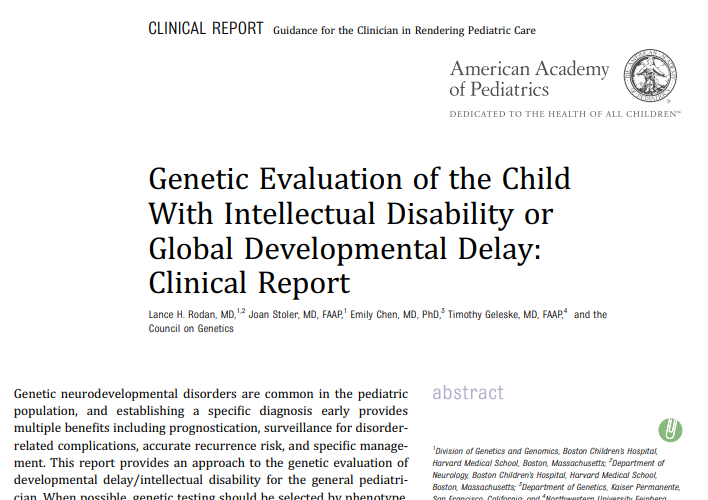The American Academy of Pediatrics now recommends exome or genome sequencing as a first-tier test for children with global developmental delay or disability.
- See AAP press release here:
- See press release from GeneDx here.
- Stock is up $65 to $90 in a couple days.
- Was trading $5-10 18 months ago.
- Market cap $2.6B.
- https://ir.genedx.com/news-releases/news-release-details/genedx-announces-american-academy-pediatrics-recommends-exome
- See GeneDx website on the topic here:
- See the new AAP guideline, Rodan et al, June 23, 2025. The 12-page PDF is open access.
- The guidance fits with recent AMCG recommendations (Rodan ref 33, Manickam 2021).
- Genome or "exome plus microarray" are given as alternatives to each other.
Rodan Abstract -
Genetic neurodevelopmental disorders are common in the pediatric population, and establishing a specific diagnosis early provides multiple benefits including prognostication, surveillance for disorder-related complications, accurate recurrence risk, and specific management.
This report provides an approach to the genetic evaluation of developmental delay/intellectual disability for the general pediatrician. When possible, genetic testing should be selected by phenotype, and typical distinguishing clinical features to facilitate this are presented. If a specific disorder or group of disorders cannot be ascertained by phenotype, an agnostic (or hypothesis-free) approach is utilized. Recommendations are provided for this agnostic approach based on diagnostic yield and also practical considerations such as test complexity and impact on management. The general guidance in this report for genetic testing does not preclude further evaluation by relevant subspecialists as necessary, including neurologists, developmental pediatricians, and clinical geneticists.
###
TLDR for Genomics Experts
In the 2025 AAP guideline authored by Rodan et al., the distinction between phenotype-driven genetic testing and agnostic testing (exome/genome sequencing) is acknowledged as conceptually important—but in practice, for some cases, clinicians and payors will continue to face a significant gray area.
While the guideline promotes a phenotype-first strategy when a specific syndrome is clinically suspected, it also strongly endorses agnostic testing as the default first-tier approach for most children with unexplained global developmental delay (GDD) or intellectual disability (ID), especially in nonsyndromic cases.
Key Observations for Genomics Stakeholders:
-
Phenotype-first testing is ideal when classic syndromic features (e.g. Angelman, Lesch-Nyhan) are evident. It can be faster and cheaper but is only effective in a minority of cases.
-
Agnostic testing (exome/genome + CMA) is now formally endorsed as first-tier by the AAP, ACMG, and other authorities for GDD/ID because of superior diagnostic yield (often 30–50% depending on severity).
-
The guideline emphasizes that exome/genome sequencing plus CMA should often be performed upfront unless there's a strong reason to begin with more targeted tests.
-
Gene panels have fallen out of favor except when families wish to avoid incidental findings or VUS burdens, or if insurance limits coverage.
-
Even within a phenotype-first mindset, uncertain or evolving phenotypes blur lines and often lead to early adoption of agnostic testing.
-
Payors and clinicians may still seek cost-based reasons to delay agnostic testing, but this is increasingly difficult to justify given the yield, cost-effectiveness, and value of early diagnosis.
-
The guideline explicitly acknowledges that resource availability, insurance limits, and physician comfort all contribute to non-uniform pathways, reinforcing the gray zone between the two paradigms.
Conclusion:
While “phenotype-driven” and “agnostic” testing are presented as alternatives, the lines between them are fluid in practice. This fuzziness is reflected in the guideline’s tiered model, which allows clinicians to adapt based on presentation, resources, and clinical suspicion.
Expect continued overlap and negotiation—clinically, financially, and policy-wise.


